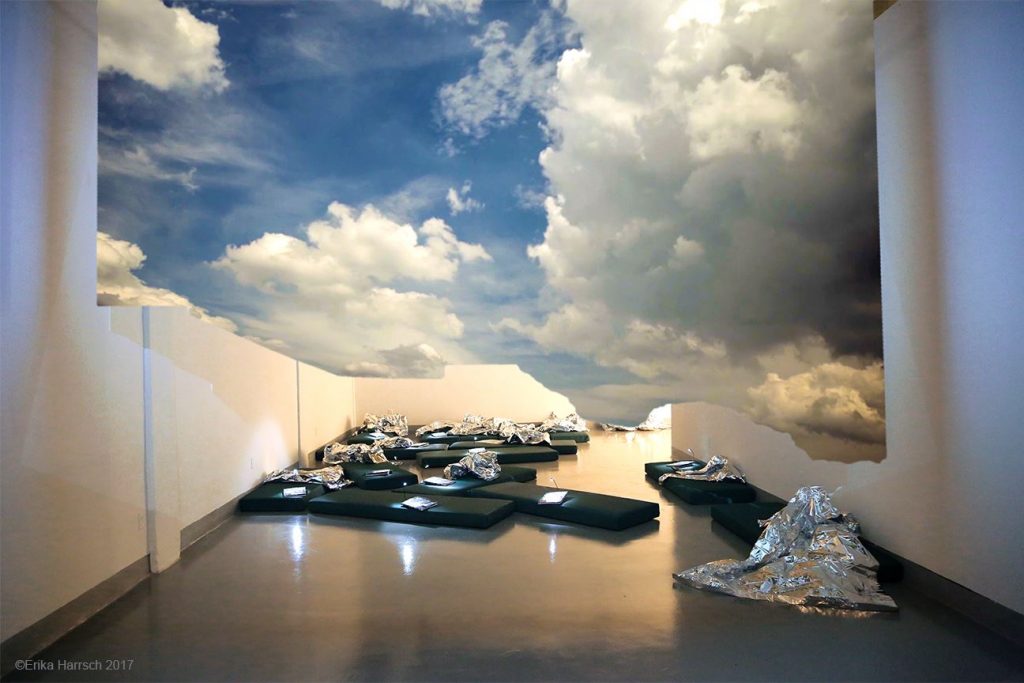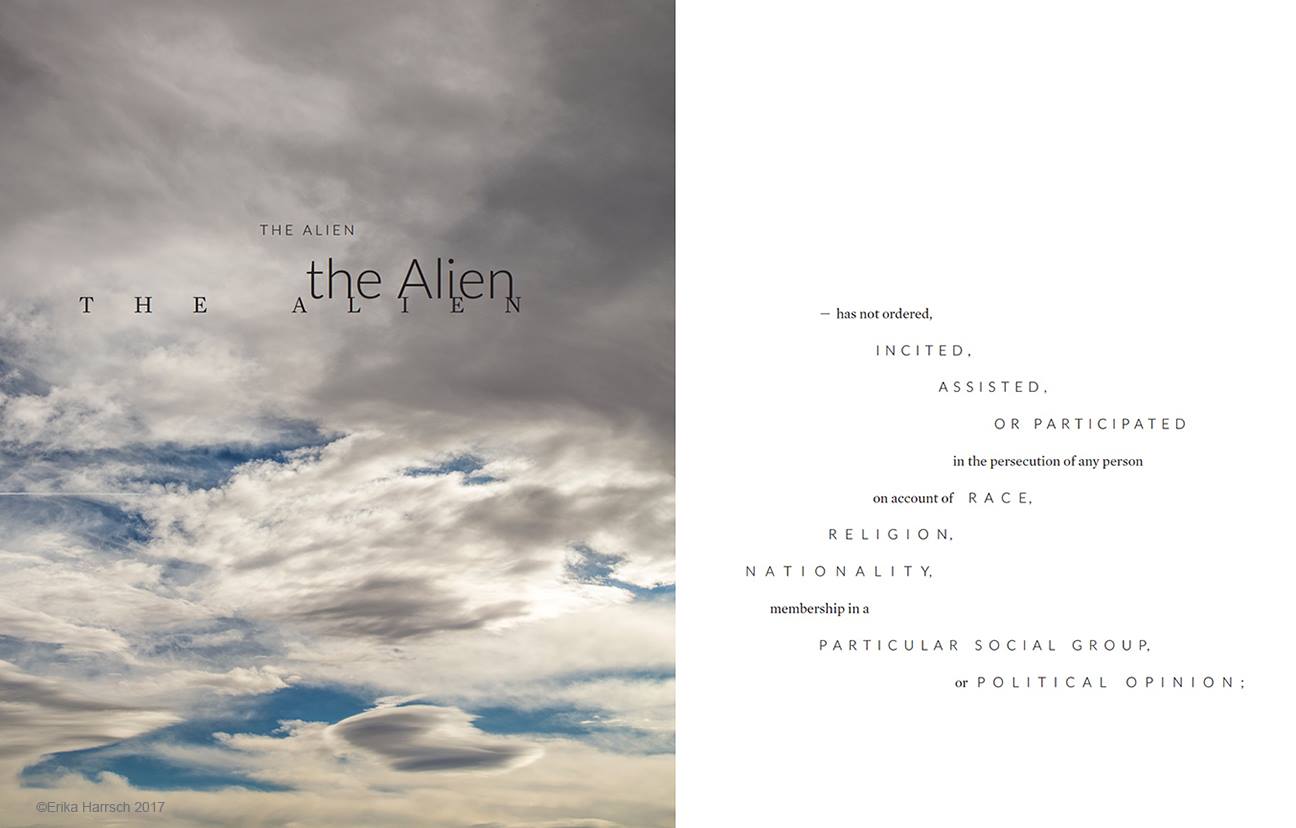La artista Erika Harrsch rinde homenaje a los niños que tratan de cruzar las fronteras
Bajo el mismo cielo… soñamos
El Rubin Center for the visual arts de la Universidad de El Paso, Texas presenta la muestra Under the same sky… we dream o Bajo el mismo cielo… soñamos, una instalación de vídeo y sonido creada por la artista Erika Harrsch y sonorizada por la cantante Magos Herrera que podrá ser visitada hasta el 29 de septiembre.
La video instalación se compone de elementos que evocan “la relatividad del espacio físico y del territorio delimitado por fronteras geopolíticas artificiales, sin embargo, bajo el mismo cielo.”

Erika Harrsch rinde homenaje a los niños que tratan de cruzar las fronteras con o sin sus padres, para comenzar una nueva vida y a todos aquellos padres que sueñan con una vida mas segura y con mejores oportunidades.

El espacio de la video instalación es delimitado por una pantalla suspendida la cual ha sido recortada a precisión con la línea divisoria de la frontera entre los Estados Unidos de América y México, sobre esta se proyecta un cielo en movimiento. Los visitantes pueden pasar por debajo de la pantalla para encontrar una serie de colchonetas estilo militar y frazadas metálicas de mylar, iguales a las que utiliza el Servicio de Inmigración y Control de Aduanas (ICE) en los centros de detención para menores indocumentados que han sido arrestados al tratar de entrar al país ilegalmente.

La pantalla suspendida que divide el espacio como una frontera, es la entrada al otro lado de la galería, donde se simula una celda de detención para menores en las instalaciones de procesamiento de Aduanas y Protección de Fronteras de los Estados Unidos, (basada en las primeras imágenes reveladas en el 2014 por periodistas en los centros de detención para menores no acompañados e indocumentados en Texas y Arizona).

El espectador esta invitado a sentarse o acostarse sobre las colchonetas en un acto de reflexión y solidaridad. Una vez ahí, puede contemplar el video del cielo en lapso de tiempo (Time lapse), creado con mas de 35,000 fotografías fijas del cielo tomadas en la proximidad de El Paso y Juárez. Al mismo tiempo, en la galería, se puede escuchar en sonido estereofónico, la evocadora interpretación musical del DREAM Act en colaboración con la cantante Magos Herrera. Las letras de la canción se encuentran dentro de los varios libros de artista diseñados por Harrsch, iluminados con las lamparitas de lectura. Dentro de estos se puede ver una colección de fotografías realizadas durante un periodo de tres años, que a su vez, son una forma de representación de la línea fronteriza. En la primera mitad de cada libro, imágenes vistas desde EUA y en la segunda, las registradas desde México. Las páginas centrales contienen la letra de la legislación a manera de poesía concreta y que se convierte en la división de los dos mundos.

“Bajo el mismo cielo … soñamos, es una reflexión sobre el derecho de libre movilidad, las consecuencias de irregularidades migratorias, los centros de detención para menores indocumentados en la frontera de México – Estados Unidos y la ley Dream-Act de la reforma migratoria en los Estados Unidos que nunca fue aceptada. En el comienzo del 2014, cientos de miles de jóvenes y familias indocumentadas de Centroamérica y México llegaron a la frontera y por la falta de protección humanitaria, la crisis migratoria se convirtió en un lucrativo negocio multimillonario para prisiones privadas y cárceles de condados, que encierran al noventa por ciento de los inmigrantes detenidos.
El Dream Act es una legislación bipartidista presentada por primera vez en el Congreso en el 2001. Conocido formalmente como Desarrollo, Ayuda y Educación para Menores Extranjeros; desde entonces, está se ha propuesto varias veces, pero aun no ha sido aprobada. Esta propuesta de ley tenía como objetivo crear un camino claro hacia la ciudadanía para los niños indocumentados que crecieron en los Estados Unidos, (Un largo proceso de varias fases que les habría concedido a los inmigrantes indocumentados, la residencia condicional y al cumplir con muchos mas requisitos, les daría la residencia permanente). Erika Harrsch.

Como complemento de la instalación y para mayor información sobre la legislación del DREAM Act y las personas a quienes afecta, puede visitar la galería contigua con la obra Los Nuevos Dreamers Americanos (2017), una serie de fotografías e historias verdaderas de los Soñadores (Dreamers), compiladas por las artistas Sylvia Johnson y Kerry Sherck de Santa Fe, NM.

Aunque no hay estadísticas precisas disponibles para documentar el número de estudiantes en UTEP que se verían beneficiados por la aprobación de alguna versión del DREAM Act, si sabemos que dentro de nuestro cuerpo estudiantil y la comunidad circundante que es el hogar de muchas familias de diferente status migratorio, se viven diferentes versiones del Sueño Americano. Tenemos estudiantes que son hijos de agricultores, quienes fueron traídos desde niños; estudiantes que han obtenido su estatus legal al integrarse al servicio militar; estudiantes que nacieron aquí pero que tienen padres o hermanos indocumentados y que viven en constante temor a ser deportados. La pregunta fundamental que DREAM Act trata de abordar – ¿Cómo podemos garantizar la seguridad, y el futuro económico de los miembros de nuestra comunidad, buenos ciudadanos que se han empeñado y trabajado exitosamente no obstante de su lugar de nacimiento? – Es una pregunta que tiene una particular relevancia en esta ciudad y en este momento histórico de nuestra nación. Así nuestra misión, esencia y compromiso en el Rubin Center, es que el arte contemporáneo sea una plataforma para crear conversaciones más profundas sobre el mundo que nos rodea. El proyecto de Erika Harrsch, Bajo el mismo cielo … soñamos, es fundamental para cumplir con nuestra misión.
—Kerry Doyle, Rubin Center Director

Under the Same Sky… we Dream
Video (Timelapse)and sound installation by Erika Harrsch, the sound collaboration by Magos Herrera.
On view until Sept 29th at The Rubin Center for the visual arts at UTEP,
El Paso, TX. http://rubin.utep.edu/
Under the same sky… we dream
By Erika Harrsch in collaboration with singer Magos Herrera for sound element.
This video and sound installation is an homage to the children who try to cross borders to start a new life with or without their parents, and to all the parents who dream of better opportunities and a safer life.
The elements that compose the piece, evoke the relativity of the physical space and territories, delimited by artificial geopolitical borders, although under the same sky. The floating screen that divides the space as a borderline. To enter the other side of the room that insinuates a holding cell at a U.S. Customs and Border Protection processing facility, (based on the first images revealed in 2014 of the Texas detention centers for unaccompanied, undocumented minors).
Under the same sky… we dream, reflects on the rights to move freely beyond borders, the consequences of unregulated migration, the detention centers for undocumented minors at the Mexico – US border and the Dream-Act legislation of the immigration reform in the United States that was never adopted. Since the beginning of 2014, hundreds of thousands of undocumented youths and families from Central America and Mexico have arrived at the border lacking humanitarian protections, turning the migration crisis into a multimillion lucrative business for private prisons and county jails, which hold ninety percent of immigration detainees.
The Dream Act is a bipartisan legislation first introduced in the Congress in 2001. Known formally as Development, Relief, and Education for Alien Minors, it has since been reintroduced several times, but has failed to pass. This bill aimed to create a pathway to citizenship for undocumented children who grew up in the United States, (a multi-phase process for undocumented immigrants that would have granted conditional residency and, upon meeting further qualifications, permanent residency.
–Erika Harrsch
The video projection of the sky, visible from both sides of the hanging screen, has been sculpted to the contours of the US-Mexico borderline. Visitors who pass under the screen will encounter a series of military-style mattresses and Mylar blankets, exactly like those used by Immigration and Customs Enforcement (ICE) in detention centers housing undocumented minors who have been caught trying to enter the country illegally.
You are invited to sit or lie on one of these mats as an act of reflection and solidarity. From your seat on the gallery floor you can watch the time-lapse video, created from more than 35,000 photographs of the sky taken in proximity to the border between El Paso and Juarez. You will be surrounded by the Magos Herrera’s evocative musical rendition of the DREAM Act, projected in stereo into the gallery space. You can follow her performance word by word in the artist books also designed by Harrsch, that are illuminated with a small, personal, clip light. The photographs in these books, taken over a period of three years, are themselves arranged along a borderline. In the front half of the books you will find images from the US side of the border, in the back half images from Mexico; the legislation, arranged by the artist in the style of concrete poetry, is found in the middle, dividing the two worlds.
If you’d like to learn more about the DREAM Act and the people it affects, you can visit the adjacent room to see The New American Dreamers photos and stories of real-life Dreamers complied by Santa Fe-based artists Sylvia Johnson and Kerry Sherck
While there are no precise statistics available to document the number of UTEP students who would be affected by the passage of some version of the DREAM Act, what we do know about our student body and the surrounding community is that it is home to many mixed-document families and all of them are living out different versions of the American Dream. We have students who are children of farmworkers, and who may have been brought here as children themselves; students who have earned their legal status through service in the military; students who were born here but who have undocumented parents or siblings that live in constant fear of deportation. The core question that the DREAM Act seeks to address – how do we ensure the security, safety and economic future of accomplished and long-standing members of our community, regardless of their place of birth? – is a question that has a particular relevance in this place and at this time in our nation’s history. Core to the Rubin Center’s mission is a commitment to using contemporary art as a springboard for deeper conversations about the world around us. Erika Harrsch’s Under the Same Sky…We Dream is central to fulfilling that mission.
—Kerry Doyle, Rubin Center Director


Comentarios: